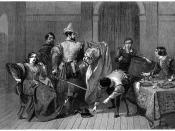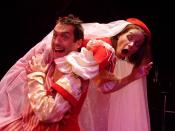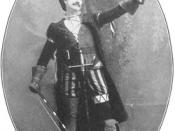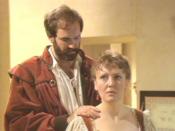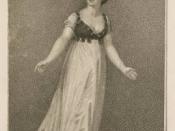The taming of the shrew is a play written by William Shakespeare, concerning many important issues and ideas, especially relating to marriage and the role of women in the Elizabethan society. In the present day the play seems to be sexist, however in the Elizabethan era it was considered to be a comedy. There are various humorous aspects of the play from an Elizabethan perspective and these include the manner in which Katherine is 'tamed', the many disguises used by the characters and finally the puns and various dialogue used by the characters.
A major aspect of why this play would by humorous to a Elizabethan audience is because of the manner in which Katherine is 'tamed' by Petruchio. Kate is originally a rough, headstrong women who tyrannises over her sister and defies the Elizabethan view of a wife. She is regarded as a shrew, and Petruchio, her husband has to 'tame' her.
The manner in which this is achieved is seen as comical from an Elizabethan perspective. Petruchio attempts to drive the headstrongness and temper out of Kate by imitating her manner. His gratuitous capriciousness demonstrates to Kate what she is like and through this she achieves self knowledge. This is shown through his callous treatment of his servants, just after being betrothed. In front of Kate, Petruchio tells them "You peasant swain, you whoreson malt-horse drudge". Apart from serving as a mirror for Kate to view her own outrageousness, Petruchio also tells her of what she will become, complimenting her on her qualities despite the fact that she is the opposite of them. An example of this is when he tells Kate "Thou art pleasant, gamesome, passing courteous".
Another manner through which a sense of humour is conveyed is through the use of disguises. Many of the characters are disguised as other characters in the play, creating confusion and humour. The disguises also create dramatic irony which adds to the comical sense. One particular scene is when the Pedant is disguised as Vincentio. The real Vincentio then meets the pedant and a comical farce arises. Through the dramatic irony the audience is informed of the characters real identities, however they do not know, causing much bewilderment on all the characters' behalf.
The dialogue which is used by the characters also aids in adding to the comedy. Puns are used to relate to characters, especially Bianca. An example is when Cambio is tuning his instrument and cries "Beee my Bianca". There are also many other puns with crude elusions, that contribute to the humour. Another example of humorous dialogue is the Latin translation by both Lucentio and Bianca. Lucentio utters a nonsensical series of words which are supposedly Latin and then translates them into word displaying his affection for Bianca. Bianca then translates them into her distrust and how she does not know him. All these various dialogues are all comical from an Elizabethan perspective.
In conclusion the Taming of the Shrew is a comical play, viewed from an Elizabethan perspective through the use of various techniques. These include the manner in which Katherine is tamed by Petruchio, the costumes used to disguise the true identity of the characters and the comical dialogue used by the characters.
SourcesThe Taming of the Shrew- William ShakespeareTaming of the Shrew- www.sparknotes.com/shakespeare/shrew
